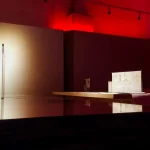John Soanes Museum, Lincoln’s Inn Fields, Architecture Exhibition London, Architect
Sir John Soane’s Museum Architecture Exhibition
Architectural Show at Lincoln’s Inn, Holborn, London, England, UK
30 Sep 2020
Sir John Soane’s Museum Reopens
Sir John Soane’s Museum Reopening News
9 Jul + 9 May + 19 Jan 2012
Sir John Soane’s Museum Exhibition
Location: Sir John Soane’s Museum, 13 Lincoln’s Inn Fields, London WC2A 3BP, UK
Let the games begin – cultural Olympiad brings an inspirational exhibition to Sir John Soane’s Museum
Stadia : Sport and Vision in Architecture 6 Jul – 22 Sep 2012
This summer London’s amazing Olympic Park will be filled to capacity, but how did the tradition of the sports stadium begin? What were the origins of the thousands of stadia and sports arenas that can now be found on every continent?
John Soane and Thomas Hardwick Restored Elevation of the Colosseum Rome 1778 pen and pencil and watercolour SM 20_5_3:
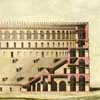
image from Sir John Soane’s Museum
In a ground-breaking exhibition, STADIA: Sport and Vision in Architecture, Sir John Soane’s Museum will trace the evolution of these iconic structures from ancient times to the state-of-the-art London 2012 stadium in Stratford – a modern-day field of dreams. Sir John Soane’s Museum will open its new temporary exhibition galleries with the first ever exhibition to explore what made stadia such inspirational cathedrals of sport, uniting people from all walks of life.
Sponsored by Populous, the official architectural and overlay design services provider to the London 2012 Olympic and Paralympic Games, and designers of the main Olympic Stadium, Stadia starts with a look at the first, permanent structures – such as the ancient stadia at Olympia and Nemea in Greece.
Rome’s Colosseum is also examined, inspiring architects like Soane and artists such as Giovanni Battista Piranesi, taking us back to a time of circuses and amphitheatres, of chariot races and gladiatorial combats.
London Olympic Stadium designed by Populous:
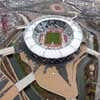
image © LOCOG
A Panathenaic amphora showing the ancient Greek armour race, terracotta lamps featuring gladiator fights, and even a large bronze goose that adorned the Hippodrome at Constantinople will all be on loan from the British Museum, celebrating the way art has been used to embellish and celebrate sports stadia throughout history.
By the Middle Ages temporary structures took the place of permanent stadia. The Palio in Siena and the Calcio Storico in Florence were just some of the sporting highlights played out in town squares, watched by fans on temporary grandstands, but architects still looked backwards for their inspiration.
The Colosseum still fired the creativity of designers and artists, and one of the greatest treasures featuring in Stadia is the Codex Coner, a Renaissance manuscript owned by Soane, which is the earliest archeologically correct record of the Colosseum, and was regularly consulted by Michelangelo.
Although fascinated by the Colosseum, Soane did not design any stadia during his long career. However, his near contemporary, the French architect Étienne-Louis Boullée, proposed the creation of a huge public circus for the centre of Paris, as part of a post-revolutionary rebuilding of the French capital.
Soane Office Royal Academy Lecture drawing plan of the colosseum Rome pen and pencil and watercolour SM 20_5_4:
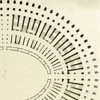
image from Sir John Soane’s Museum
The second half of the Stadia exhibition will bring us up to date with the design of the modern sports stadium, displayed in the new state-of-the-art Soane Gallery, designed by the architects Caruso St John.
Here, the London 2012 Stadium in Stratford will take centre stage, featuring a highly-detailed model of the twenty-first century sports arena and its legacy of environmental sustainability.
As sports fans from across the globe cheer on their athletes in London’s Olympic Park, the past will be firmly at the centre of today’s modern design.
Populous, currently working on 35 of the London 2012 competition venues has helped to bid, plan, manage and design more than 400 major event venues. The Olympic portfolio includes three main stadiums (Sydney 2000; London 2012 and Sochi 2014); 13 Games stadium and arena venues; overlay and master planning for 10 Games; and preparation of 12 Olympic Games Bids. In addition to facility design, Populous provides strategic guidance for members of the Organizing Committee on issues such as land acquisition, transportation and commodities. Beyond the Olympics, Populous event planning specialists have organized 26 NFL Super Bowls, 4 FIFA World Cup tournaments, 10 various World Games and Bids, 12 Major League Baseball All Star Games and 3 NCAA Final Four tournaments.
Tim Knox, Director of Sir John Soane’s Museum and the force behind its £7m restoration project, is delighted that the Cultural Olympiad has created the opportunity to bring ancient and modern stadia together and celebrate the Soane’s new galleries:- “The great stadia of the ancient world like the Colosseum are the ancestors of the innovative sports architecture of today’s Olympiad” says Knox.
“Roman reliefs of chariot racing in a hippodrome, Soane’s drawings of the Colosseum, and the oval form, tiered seats, and retractable ‘velarium’ of the London 2012 Stadium, demonstrate the inexorable impact these ancient architectural design have had on modern forms.
Stadium in a desert climate:
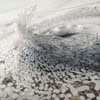
image © POPULOUS
By hosting this exhibition in our new exhibition galleries in the heart of Sir John Soane’s museum, we celebrate the ancient roots of today’s Olympics, whilst looking forward to architectural visions of the future”.
Rod Sheard, Senior Principal at Populous, the Olympic Stadium architect said: “Stadia have become the ‘cathedrals’ of the 21st century. In the summer of 2012, the London Olympic stadium will be one of the most viewed buildings in history, and will bring a pilgrimage of national and international athletes and spectators to celebrate a unique experience. We are at a point in which a stadium, more than any other building type in history, has the ability to shape a town or a city.
It puts a community on the map –establishing an identity and providing a focal point in the landscape. It is by observing the past that we can move forward and create these catalysts that regenerate complete areas and become part of the legacy of a larger process. We are delighted to sponsor the first ever exhibition devoted to the subject of stadia design, which will give visitors some fascinating insights into the design of sporting venues.”
Sir John Soane’s Museum – Information
The Museum: The architect Sir John Soane’s house, museum and library at No 13 Lincoln’s Inn Fields has been a public museum since the early 19th century. On his appointment to the Royal Academy in 1806 Soane (1753-1837) began to arrange his collected books, classical antiquities casts and models so that students of architecture might benefit from access to them. In 1833 he negotiated an Act of Parliament to preserve the house and collection after his death for the benefit of ‘amateurs and students’ in architecture, painting and sculpture.
Today Sir John Soane’s Museum is one of the country’s most unusual and significant museums with a continuing and developing commitment to education and creative inspiration. The museum is open free: Tuesday to Saturday inclusive, 10am-5pm. Also on the first Tuesday evening of each month, 6-9pm. Closed Sunday, Monday, bank holidays and Christmas Eve. www.soane.org
A new Soane Gallery and Shop is to be created – designed by Caruso St John Architects, London.
Sir John Soane’s House
1812-34
John Soane, Architect
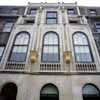
photo © Adrian Welch
Sir John Soane Museum
Location: Sir John Soane Museum, Lincoln’s Inn, London, England, UK
Architecture in London
Contemporary Architecture in London
Lincoln’s Inn Fields building : The Old Curiosity Shop
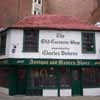
photo © Adrian Welch
Fleet Street Buildings
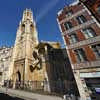
photo © Nick Weall
Buildings close by to Sir John Soane’s Museum include:
St Mary le Strand

photo © Nick Weall
Somerset House
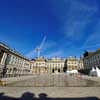
photo © Nick Weall
Comments / photos for the Sir John Soane’s House Architecture page welcome

